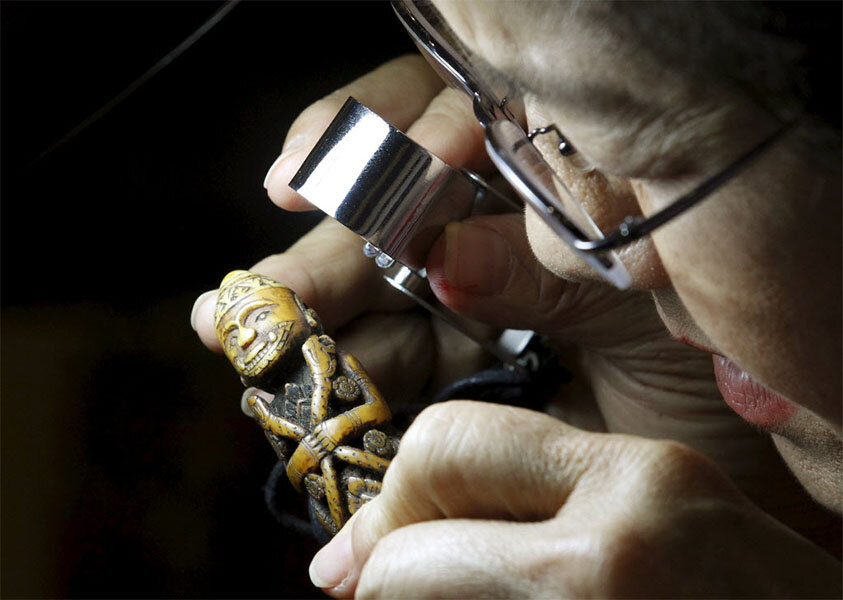New initiatives aim to prevent poaching
Loading...
In the late 2000s, the African elephant faced perhaps its biggest challenge yet, with demand for ivory spiking in Asia. But action on the supply and demand ends of the ivory trade could help to curb today’s poaching crisis.
In March, Kenyan President Uhuru Kenyatta set fire to more than 30,000 pounds of confiscated ivory at Nairobi National Park and pledged to destroy additional stocks. Past Kenyan presidents had ordered such burnings, but this most recent one represents the largest consignment ever destroyed in the country.
Other new initiatives in Kenya are aimed at preventing further poaching: A paramilitary force will bolster enforcement of anti-poaching laws in the nation’s wildlife parks, the Kenyan Wildlife Service has issued a new strategic approach for educating communities that interact with wildlife, and the country has begun collaborating with neighboring countries to share information on both poaching and trafficking. (Drone patrols play a role.)
According to the African Wildlife Foundation, authorities in Ethiopia have arrested more than 700 people for smuggling ivory and, just two weeks after the ivory-burning event in Kenya, the Ethiopian government destroyed its own ivory stockpile in Addis Ababa. It will deploy detection dogs, being trained by the foundation in Tanzania, to Bole International Airport.
Though not as notorious for its role on the demand side, the United States has made moves to control the market with new legislation prohibiting the sale of ivory in a number of states, including Massachusetts and Florida.
Then there are countries like Thailand, where ivory trade is the world’s largest unregulated market, according to the World Wildlife Foundation. As a member party to the Convention on International Trade in Endangered Species, Thailand was forced to take measures aimed at shutting down the illegal market by the end of March. Private owners of ivory objects were required to declare their inventories by late April in order to avoid fines and prison time. More than 38,000 collectors and shopkeepers complied. A day before the deadline, Thai customs officials seized four tons of illegal ivory from Congo.
Efforts have also been introduced in China. Between 2010 and 2012, more than 100,000 elephants were illegally killed for their ivory, according to WildAid, and the organization says that as much as 70 percent of that illegal ivory has made its way into China, or will. A little more than a year ago, though, Chinese officials ordered the destruction of more than 10,000 pounds of confiscated ivory at a public event, a first. And in February, officials from the State Forestry Administration announced a one-year ban on ivory imports. Earlier that month, Action for Elephants, a Britain-based advocacy group, brought together celebrities and conservationists to call on Chinese President Xi Jinping to outlaw the selling and purchasing of ivory in an open letter.
Kathleen Garrigan of the African Wildlife Foundation calls the ban a welcome move, but one that won’t stop poaching on the ground; it applies only to carvings or trinkets brought into the country by travelers.
“Both the time frame and the scope of the ban are too limited,” Ms. Garrigan says. “If China banned all ivory trade ... and for a period much longer than one year, then we would likely see an immediate and precipitous decline in elephant poaching....”
Still, a survey by WildAid found that Chinese citizens’ attitudes about ivory may also be changing. As of last year, about 70 percent of respondents thought elephant poaching was a problem, compared with about 46 percent in 2012. And among Beijing residents who participated in the survey, the percentage of those who knew ivory comes from poached elephants more than doubled from 25 percent to 53 percent.
But not all are convinced that these announcements mean a win for the African elephant. Patrick Gathara, a blogger and political cartoonist in Kenya, says the burning of ivory stocks is mainly for show.
“Every president since Moi, then Kibaki and now Kenyatta, they’ve all burnt ivory. But the fact is they haven’t dealt with poaching as an issue...,” says Mr. Gathara.
Adds Garrigan: “We ... need to see governments from Africa to Asia demonstrate their willingness to go after the well-protected, often well-connected, higher level criminals that operate with impunity.”








